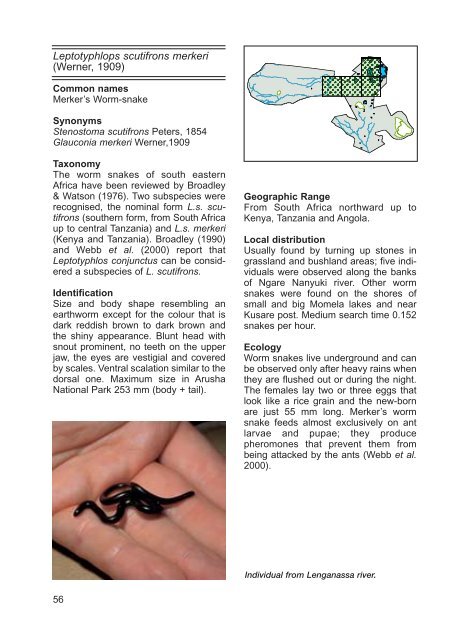field guide to the amphibians and reptiles of arusha national park
field guide to the amphibians and reptiles of arusha national park
field guide to the amphibians and reptiles of arusha national park
Create successful ePaper yourself
Turn your PDF publications into a flip-book with our unique Google optimized e-Paper software.
Lep<strong>to</strong>typhlops scutifrons merkeri<br />
(Werner, 1909)<br />
Common names<br />
Merker’s Worm-snake<br />
Synonyms<br />
Stenos<strong>to</strong>ma scutifrons Peters, 1854<br />
Glauconia merkeri Werner,1909<br />
Taxonomy<br />
The worm snakes <strong>of</strong> south eastern<br />
Africa have been reviewed by Broadley<br />
& Watson (1976). Two subspecies were<br />
recognised, <strong>the</strong> nominal form L.s. scutifrons<br />
(sou<strong>the</strong>rn form, from South Africa<br />
up <strong>to</strong> central Tanzania) <strong>and</strong> L.s. merkeri<br />
(Kenya <strong>and</strong> Tanzania). Broadley (1990)<br />
<strong>and</strong> Webb et al. (2000) report that<br />
Lep<strong>to</strong>typhlos conjunctus can be considered<br />
a subspecies <strong>of</strong> L. scutifrons.<br />
Identification<br />
Size <strong>and</strong> body shape resembling an<br />
earthworm except for <strong>the</strong> colour that is<br />
dark reddish brown <strong>to</strong> dark brown <strong>and</strong><br />
<strong>the</strong> shiny appearance. Blunt head with<br />
snout prominent, no teeth on <strong>the</strong> upper<br />
jaw, <strong>the</strong> eyes are vestigial <strong>and</strong> covered<br />
by scales. Ventral scalation similar <strong>to</strong> <strong>the</strong><br />
dorsal one. Maximum size in Arusha<br />
National Park 253 mm (body + tail).<br />
56<br />
Geographic Range<br />
From South Africa northward up <strong>to</strong><br />
Kenya, Tanzania <strong>and</strong> Angola.<br />
Local distribution<br />
Usually found by turning up s<strong>to</strong>nes in<br />
grassl<strong>and</strong> <strong>and</strong> bushl<strong>and</strong> areas; five individuals<br />
were observed along <strong>the</strong> banks<br />
<strong>of</strong> Ngare Nanyuki river. O<strong>the</strong>r worm<br />
snakes were found on <strong>the</strong> shores <strong>of</strong><br />
small <strong>and</strong> big Momela lakes <strong>and</strong> near<br />
Kusare post. Medium search time 0.152<br />
snakes per hour.<br />
Ecology<br />
Worm snakes live underground <strong>and</strong> can<br />
be observed only after heavy rains when<br />
<strong>the</strong>y are flushed out or during <strong>the</strong> night.<br />
The females lay two or three eggs that<br />
look like a rice grain <strong>and</strong> <strong>the</strong> new-born<br />
are just 55 mm long. Merker’s worm<br />
snake feeds almost exclusively on ant<br />
larvae <strong>and</strong> pupae; <strong>the</strong>y produce<br />
pheromones that prevent <strong>the</strong>m from<br />
being attacked by <strong>the</strong> ants (Webb et al.<br />
2000).<br />
Individual from Lenganassa river.

















